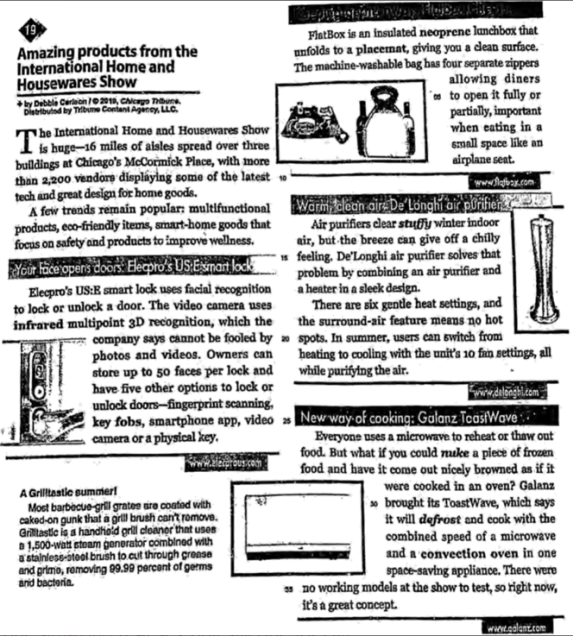Animated movies use drawings instead of real people. Artists must draw thousands of pictures and each picture must be a little different. For example, if the movie-maker wants to show a girl running, the artist must draw her feet in different places in each picture. When the pictures are shown very quickly, one after the other, it looks like the girl is running. Walt Disney was not the first or only person to use animation in movies, but he is the most renowned. His first Mickey Mouse cartoon, produced in 1927, was called Plane Crazy. This was a short, silent movie about the adventures of a little mouse.
Many people in the movie business thought that animation was only appropriate for short cartoons. Disney did not agree with them. He believed that he could tell any kind of story using animation. His first long movie was Snow White and the Seven Dwarfs. Disney spent all his money making this movie. Fortunately, it was a great success. He made Pinocchio next and then Dumbo (about a baby elephant), and he didn’t look back after this.
When we think of Disney, however, we don’t only think of movies, we also think of Disneyland. There are Disneylands in Japan, the United States of America and France. They are large parks where people can meet Disney’s characters and visit scenes from his movies.
Although Walt Disney made many of the famous movies many years ago, they are as popular now as they were when he made them. Today we can buy them on video and see them in movie theatres from time to time. When Walt Disney began making his animated cartoons all those years ago, people drew all the pictures by hand. Nowadays computers do much of his work.
______________________________________________________________________________________________________________________________________________________________________________________________________________________________________________________________________________________________________________________________________________________________________________________________________________________________________________________________________________________________________________________________________________________________________________________________________________________________________________________
2 . Why can’t we stop longing for the good old days
People in many countries are longing for the good old days. But when exactly were the good old days? Podcaster Jason Feifer devoted an episode of his program to this question. The most popular answer seemed to be the 1950s, so Mr. Feifer asked historians whether Americans in that decade thought it was particularly pleasant. Definitely not. In the 1950s, American sociologists worried that rampant individualism was tearing the family apart. There were serious racial and class tensions, and everyone lived under the nuclear threat.
In fact, many in the 1950s thought that the good old days were to be found a generation earlier, in the 1920s. But in the 1920s, child psychologist John Watson warned that because of increasing divorce races, the American family would soon cease to exist. Many people at the time idealized the Victor inn era, when families are strong and children respected their elders.
Why are human beings always so nostalgia for past eras that seemed difficult and dangerous to those who lived through them? One possibility is that we know we survived past dangers, so they seem smaller now. But we can never be certain we will solve the problems we are facing today. Radio didn't ruin the younger generation, but maybe the smart phone will.
Another reason is that historical nostalgia is often colored by personal nostalgia. When were the good old days? Was it, by chance, the incredibly short period when you happened to be young? A U.S. Poll found that people born in the 1930s and 1940s thought the 1950s was America’s best decade, while those born in the 1960s and 1970s preferred the 1980s.
This kind of nostalgia has neurological roots. Researchers have found that we encode more memories during adolescence and early adult hood than any other period of our lives, and when we think about the past, this is the period we most often return to. Moreover, as we grow more distant from past events, we tend to remember them more positively.
Obviously, some things readily were better in the past. But our instinctive nostalgia for the good old days can easily deceive us, with dangerous consequences. Longing for the past and fear of the future inhibit the experiments and innovations that drive progress.
Vaccination, steam engines, railroads and electricity all met with strong resistance when they were first introduced. The point isn’t to show how silly previous generations were. The same kinds of anxieties have been expressed in our own time about innovations like the internet, video games and stem-cell research.
And not all fears about the future are unbounded. New technologies do result in accidents, they disturb traditional cultures and habits, and they destroy old jobs while creating new ones. But the only way to learn how to make the best use of new technologies and reduce risks is by trial and error. The future won’t be perfect, but neither were the good old days.
1. The word “rampant” in paragraph 1 is closest in meaning to ________| A.limited | B.reasonable | C.uncontrolled | D.traditional |
| A.when American families still remained strong and children respected their elders |
| B.that was believed by Americans born in the 1930s and the 1940s to be the best decade |
| C.that saw a sharp increase in individualism and divorce rate in American society |
| D.when radical and class tensions became more serious but people no longer lived under the nuclear threat |
① people have a better memory of adolescence and early adulthood.
② More dangerous things happen during their youth and they learned how to survive them.
③ The dangers in youth were smaller and easier for people to deal with.
④ people remember events in their youth more positively as time goes by.
| A.①② | B.①③ | C.①④ | D.②④ |
| A.The current generation is not as silly As the previous generations. |
| B.It is unwise to be simply opposed to any new inventions and technologies. |
| C.People are constantly deceived by their instinctive nostalgia for the good old days. |
| D.The internet, video games and stem-cell research pose great threats to humanity. |
3 . In American culture, I am noticing a lack of respect, especially among children. This should be treated
In 1995, I spent a couple of months in Kenya where I lived with a pastor’s family. This pastor was a part of the Maasai tribes that have some unique customs. One of them is the
In my early 20’s, I worked at a children’s home in South Carolina where the children from 4 to 19 years old were taught to respect their elders. They
Immanuel Kant expressed two
| A.passionately | B.steadily | C.publicly | D.alarmingly |
| A.challenging | B.faking | C.piloting | D.abandoning |
| A.assistance | B.greeting | C.blessing | D.guarantee |
| A.come forward | B.drop by | C.show off | D.fall down |
| A.pretend | B.suspect | C.determine | D.acknowledge |
| A.located | B.ranked | C.addressed | D.defied |
| A.delight | B.delay | C.decline | D.distress |
| A.gesture | B.secret | C.behavior | D.authority |
| A.peers | B.enemies | C.guards | D.owners |
| A.controversial | B.accepted | C.foreign | D.equivalent |
| A.twisting | B.imposing | C.banning | D.sparing |
| A.reason | B.solution | C.harmony | D.consciousness |
| A.similarity | B.response | C.obedience | D.approach |
| A.environmental | B.external | C.voluntary | D.flexible |
| A.luxuries | B.glories | C.instruments | D.models |
4 . Deep below the ground, radioactive elements break up water molecules(分子), producing ingredients that can fuel subsurface life. This process, known as radio-lysis(辐射分解), has sustained bacteria in isolated, water-filled cracks on Earth for millions to billions of years. Now a study published in Astro-biology shows that radiolysis may have supported life in the Martian subsurface.
Dust storms, rays in the universe and solar winds ruin the Red Planet's surface. But below-ground, some life might find refuge. "The environment with the best chance of habitability on Mars is the subsurface," says Jesse Tarnas, a planetary scientist at NASA. Examining the Martin underground could help scientists learn whether life could have survived there. And the best subsurface samples available today are Martin meteorites(陨石)that have crash-landed on Earth.
Tarnas and his colleague evaluated the mineral makeup and radio-active element abundance in the Martin surface using satellite and rover data. They input these data into a computer model that simulated(模拟)radiolysis to see how efficiently the process would have generated hydrogen gas and other chemical ingredients that can sustain the underground bacteria. The researchers report that if water was present, radiolysis in the Martin subsurface could have sustained life for billions of years and perhaps still could today.
Scientists previously studied Mars radiolysis, but this marks the first estimate using Martin rocks to quantify the planet's subsurface habitability. Tarnas and his colleagues also evaluated the potential richness of life in the Martin underground and found that as many as a million bacteria could exist in a kilogram of rock.
The most habitable meteorite samples analysed appeared to be made of a rock type called regolith breccia. "These are thought to come from the southern highlands of Mars, which is the most ancient area on Mars," Tarnas says.
Underground life, as described by this research, would require water and it remains unknown if groundwater exists on the planet, says Lujendra Ojha, a planetary scientist at Rutgers University. Determining whether the Martin subsurface contains water will be an important next step, but this investigation helps to motivate that search. Ojha says, "Where there is groundwater, there could be life."
1. Scientists believe the Martian subsurface might be habitable probably because _________.| A.the Martin surface absorbs rays in the universe |
| B.radio-lysis may exist in the Martian underground |
| C.radiation combines ingredients for subsurface life to survive |
| D.cracks in Martian meteorites overflow with bacteria |
| A.To measure the Martian habitability below-ground |
| B.To simulate the process of producing hydrogen. |
| C.To help life find shelter from solar winds |
| D.To explore the source of hydrogen gas. |
| A.Tarnas was the first to study Mars radiolysis. |
| B.The Martian underground proved to be rich in bacteria. |
| C.The southern highlands of Mars are the most habitable. |
| D.The existence of groundwater is key to the investigation findings. |
| A.the reason for no life on the Martian surface |
| B.the source of data for the study of Martian habitability |
| C.the possibility of Mars sustaining life through radiation |
| D.the richness of radioactive elements below the Martian surface |
5 . Care for a zoom-in observation of animals with no bars between you and the observed opposed to ordinary zoos? Where to have close-up encounters with some of the world’s most rare animals? We are revealing for you.

Right whales, Bay of Fundy, Canada
Northern right whales are on the brink of extinction, but survivors arrive in the Bay of Fundy each summer (May through October) to feed east of Grand Manan Island. They are recognized by a broad back and no dorsal fin, which distinguish them from other whales entering the bay.
Planning: Whale-watching tours operate out of Digby Neck peninsula on Nova Scotia and nearby islands, such as Brier Island, St. Andrews, Grand Manan Island, and Deer Island.

Grizzly bears, Alaska, USA
Grizzlies like salmon. In mid-July and again in mid-August, grizzlies make for Alaskan rivers to hook out the fish with their formidable claws. The bears gather in large numbers at rapids and pools, sometimes fighting for the best sites. Brooks Falls in Katmai National Park, and Fish Creek, near Hyder, have viewing platforms.
Planning: Most fishing sites are accessed by chartered light aircraft and a hike. Hyder is off the Stewart-Cassiar Highway.

Monarch butterflies, Sierra Chincua, Mexico
Each fall, millions of North American monarch butterflies migrate thousands of miles to the oyamel fir forests of the Transvolcanic Mountain Range, in the state of Michoacán. They flock intimately on tree trunks, bushes, and on the ground, fully showing their gregarious nature and occupy Sierra Chincua and four neighboring hills that make up the Monarch Butterfly Biosphere Reserve.
Planning: Chincua is one of two hills in the reserve open to the public from November through March.

Komodo dragons, Komodo Island, Indonesia
Landing on Komodo, you would feel like stepping back to a time when dinosaurs ruled the Earth, as park maps reported, “Here be dragons!” This mountainous volcanic island is home to the world’s largest living lizard – the Komodo dragon. Weighing 79 to 91kg, the Komodo dragon has a tail as long as its body. You can hike to a viewpoint at Banugulung and watch as park rangers feed food to the lizards, some of which are more than 10ft long.
Planning: Komodo is reached solely by boat from Bima (on eastern Sumbawa) or Labuan Bajo (on western Flores).

Wildebeest migration, Serengeti, Tanzania
Undoubtedly the world’s most spectacular wildlife sight is the annual wildebeest migration, when 1.4 million wildebeest and 200,000 zebras and gazelles are on the move across the Serengeti plains. The animals are trekking to chase the clean water and fresh grass. Along the way, lions and hyenas stalk them, and crocodiles lie in wait.
Planning: The herds migrate across Tanzania from December through July, and then pass through the Masai Mara in Kenya in August and September.
1. In which place can a variety of types of animals be viewed?| A.Alaska. | B.Sierra Chincua. | C.Komodo Island. | D.Serengeti. |
| A.being able to climb | B.preferring group living |
| C.migrating in huge numbers | D.moderate in temper |
| A.Right whales are distinguished from other whales by unique appearance features. |
| B.Viewing spots for grizzly bears can be reached through air and on foot. |
| C.Komodo dragons are similar to dinosaurs in living period. |
| D.Wildebeest herds travel to pursue favorable food conditions. |

1. In order to be popular on the show, an item should have one of the following selling points except ________.
| A.reasonable price | B.multiple functions | C.home automation | D.eco-friendly system |
| A.Apart from facial recognition, there is no other way to lock or unlock Elecpro’s US:E. |
| B.De’ Longhi air purifier can only be used in summer because it gives a chilly feeling. |
| C.The Galanz ToastWave has not come onto the market yet. |
| D.Despite the germ-away experience it provides, the Flatbox Cheers itself is hard to clean. |
| A.Scientific journal. | B.Education magazine. |
| C.Advertisement brochure. | D.Local newspaper. |
7 . The US Institute of Electrical and Electronics Engineers (IEEE) recently asked scientists, lawyers, social scientists and other experts to consider some of these ethical dimension. To give two examples: on privacy, as we let more listening devices into our homes, how do we prevent the data they collect falling into the wrong hands through hacking (黑客) or simply being sold between companies without us receiving any money? Another example: mixed reality, including virtual reality, will become pervasive in the next few years. As we move from headsets to what the IEEE committee describes as “more delicate sensory enhancements” we will use technology to live in an illusory world in many aspects of our lives. How do we balance the rights of the individual, control over our virtual identity, and the need to live and interact on a face-to-face basis while being empowered to live rich lives in mixed reality?
There is, of course, always a tension between innovation and regulation. But it can often seem that giant steps are taken in technology with minimal public discussion. Take the self-driving car: although it may be safer than human drivers and is likely to save more than a million lives a year worldwide, it will also take jobs from drivers, traffic police, sign-makers, car-repair companies, carmakers and more. Is this a bargain we want to make? In taking that decision, have we given thought to a car that knows everywhere we go, decides routes, perhaps, based on paid advertisement from shops along the way—and listens and sees everything we do on board? What will happen to that data and can it be kept safe?
Additionally, while some worry about the uncommon “trolley problem” of whom the car should choose to hit in a strange accident—an old lady or a mother and baby—perhaps the more frequent issue will be how we find out what the algorithm (运算程序) was thinking at the time of an accident, because AIs (Artificial Intelligence) are self-learning and devise their own strategies.
Similar concerns are emerging over the internet of things. Robot vacuum-cleaners already plot cleaning cycles using computer-aided vision that, for some models, is relayed to their manufacturers. As more things at home become connected, they will be hackable and the data they collect saleable.
It’s time for some messy, democratic discussions about the future of AI.
1. Two examples in paragraph 1 are used to________.| A.shed some light on hacking in our modern life |
| B.lead the reader to think of ethical issues brought by hi-tech |
| C.lead in the following example concerning the self-driving car |
| D.list the existing problems that caught the attention of experts |
| A.intelligent | B.powerful | C.widespread | D.skillful |
| A.innovation should be accompanied by guidelines to relieve tension |
| B.more giant innovative steps will lead to fewer public discussion |
| C.disadvantages of the self-driving car will outweigh its advantages |
| D.artificial intelligence fails to have a promising and bright future |
| A.expose some underlying problems in high-technology |
| B.call on professionals to enforce law and order |
| C.illustrate AI’s abilities in self-devising and self-learning strategies |
| D.display our inter-connected computer-aided life in future |
8 . An interesting question in humankind’s development is, when did we begin to think critically? In other words, when did we turn from animals focused only on the daily struggle to avoid starvation to humans who could think symbolically about the word around us? However, answering this question is not easy as thinking leaves no fossils to discover.
A commonsense assumption is that higher levels of thought go hand-in-hand with verbal language, because higher thinking, such as creative thought, would naturally seek a means of expression. So tracing the development of language could give an approximate idea of when humans began to think critically.
Interestingly, we do have some fossil evidence related to speech. Animals whose larynx (voice box) is placed high in their throats are unable to produce the variety of sounds necessary for speech. Fossil bones tell us that in early humans, the larynx was originally high in the throat. However, by about 200,000 years ago, it had moved lower in the throat. This lowering provided a larger sound chamber (the space in the throat and the mouth) in which passing air could be controlled by the tongue, making a wide range of sounds and rhythms possible.
So humans were physically able to speak around 200,000 years ago, but when did they actually start doing so? Estimates range from 35,000 to 100,000 years ago. But with no physical evidence of ancient language use, we need another approach to determine more precisely when humans began to speak - and to think critically.
Professor Richard Klein of Stanford University suggests that art may be the key. After all, ability to create or appreciate art is a uniquely human train. If ancient humans had the imagination to create a work of art (which in itself is a means of communication), then it seems highly likely that they would possess the primary means of communication: language. This suggests that the first works of art can be considered indicators of when language and critical though began.
Until recently the earliest art was believed to be cave paintings, carved figures, and jewelry found in southwestern Europe and thought to data from about 40,000 years ago. This suggested that humans first became capable of critical thought about 40,000 years ago. However, this time frame was recently overturned by an exciting discovery in South Africa. Anthropologist Christ Henshilwood spent more than ten years exploring a cave there. He found many well-made tools, but more intriguing were the 8,000 pieces of ochre, a soft stone that can be turned into paint. Hensilwood’s breakthrough came in 1999 when he found an ochre piece with lines cut in a careful pattern. In other words, it was deliberate artistic design. Henshilwood had found the oldest piece of art yet, its date of origin set at 70,000 years — nearly 30,000 years before the art in Europe.
Based on Henshilwood’s discovery, it seems that humans began to speak and think critically at least 70,000 years ago.
1. ______ made humans physically able to speak.| A.The evolution of the tongue |
| B.The lowering of the larynx |
| C.The appearance of various sounds |
| D.The higher thinking |
| A.No other animals than humans can enjoy art. |
| B.Before 1999, Africa was thought to be the origin of art. |
| C.Without creative though, humans would be unable to speak. |
| D.Evidence of ancient language use was once found in Europe. |
| A.30,000 |
| B.40,000 |
| C.70,000 |
| D.200,000 |
| A.How did humans stop struggling for starvation? |
| B.When did humans become able to create art? |
| C.How did humans communicate more freely? |
| D.When did humans begin to think? |
9 . Did Tea and Beer Bring About Industrialization?
Professor Macfarlane has spent decades trying to understand the mystery of the Industrial Revolution. Why did it happen in Britain at the end of the 18th century?
Macfarlane compares the question as a puzzle. He
Historians had noticed one interesting factor around the mid-18th century that required the
Macfarlane looked to Japan, which was also developing large cities at the same time. Waterborne diseases were far fewer in Japan than in Britain. Could it be the
| A.claims | B.rejects | C.proposes | D.suspects |
| A.objections | B.arguments | C.complaints | D.conditions |
| A.take off | B.keep up | C.look over | D.knock out |
| A.task-based | B.self-centered | C.market-driven | D.man-made |
| A.inferred | B.convinced | C.concerned | D.impressed |
| A.intention | B.discussion | C.attention | D.explanation |
| A.temporarily | B.deliberately | C.economically | D.doubtfully |
| A.predicted | B.revealed | C.concluded | D.reviewed |
| A.spreading | B.catching | C.discovering | D.controlling |
| A.introduced | B.reduced | C.uncovered | D.avoided |
| A.sacrifice | B.variety | C.quality | D.popularity |
| A.arrangement | B.expectation | C.coincidence | D.suspension |
| A.guesses | B.declares | C.boasts | D.modifies |
| A.entitled | B.deleted | C.described | D.simplified |
| A.guidance | B.observation | C.impression | D.logic |
10 . When asked in 1993 to comment on accusations that the movie In the Name of the Father distorts (曲解) contemporary British and Irish history, female lead Emma Thompson responded that she couldn't care less. Even since the premiere (首映) in 1915 of The Birth of a Nation, filmmakers have rewritten history to create top-dollar entertainment. The films are very persuasive: well-made movies hold your interest continuously, drawing your attention to “what happens next,” and pulling you forward with no time to reflect on individual scenes until the final credits roll. The result: you don't remember much about a movie after watching it for the first time. For this reason, movies have extraordinary power - unmatched by any other medium - to leave you with a strong sense of what is right and what is wrong, who is bad and who is good, even though critical details presented in the movies may be false.
Well, so what? They're just movies. In fact they're not just movies. Millions of Americans are devoted history lovers, and they pack theatres every time new movies about historical figures or events come to town. Saving private Ryan and Titanic drew viewers and cash for months. Many high school teachers screen movies in the classroom. Clearly countless Americans get most of their history from television and the big screen.
Some of the industry's finest historical and period films premiered during the past decades. But the 1960s also saw a number of politically charged history-based movies full of factual distortions and, occasionally, outright lies. Today the trend continues on a larger scale: many movies released in the 1990s and the first decade of the 21*t century reflect lack of respect for solid, reliable history.
History Goes to the Movies is a source of information and, it is hoped, entertainment for everyone interested in the actual history behind a wide selection of movies grouped into twelve sections--11 covering historical periods and events and twelfth containing biographies and period films. Each movie review includes an essay on the history covered in one or more movies, and a brief plot summary. Star ratings (five stars: don't miss it) reflect each movie's historical accuracy and - to a much lesser extent --- its power to amuse.
Obviously, expecting textbook accuracy from movies would be ridiculous-and producers have delivered a remarkable number of historically faithful movies. But some of them get too much of their history wrong. History Goes to the Movies is a guide, however imperfect, for readers and viewers aiming to get it right.
1. Emma Thompson said ________ that In the Name of the Father was historically inaccurate.| A.it didn't matter. | B.it was upsetting. |
| C.It aroused her attention. | D.it wasn't obvious. |
| A.some movies are much more profitable than others |
| B.movies serve more purposes than entertaining views |
| C.movies tend to provide viewers with false details |
| D.the movies about historical figures attract history lovers |
| A.It is aimed at those who take interest in biographies. |
| B.It rates a movie mainly according to how amusing it is. |
| C.It introduces a movie's story as well as its related history. |
| D.It focuses on the movies that presented history in a funny way. |
| A.criticize the film industry's favoring entertainment over truth |
| B.point out which films presented history in a wrong way. |
| C.call on film directors to show respect for history |
| D.introduce a book involving history-based films |



